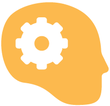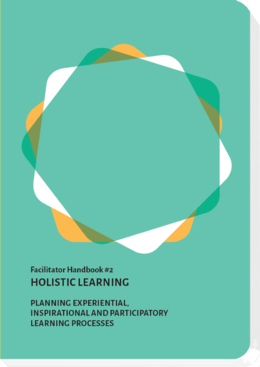|
|
| (84 intermediate revisions by the same user not shown) |
| Line 1: |
Line 1: |
| | __NOTOC__ | | __NOTOC__ |
| − | <div class=teaser-text>Learning styles are different and when using methods, that address different senses or ways of expression we may have a bigger impact on the learning outcome of our participants. The challenge is that everybody feels attracted, although not all share the same bias concerning methods. Therefore we advocate for a mix of different methods. Beyond personal preferences creative and diversified learning arrangements that address different senses stimulate participants' motivation. </div> | + | <div class=teaser-text>Learning preferences vary. Methods that offer variety and provide opportunities for all in the way they are delivered support inspiring and rewarding learning experiences. A good mix and variety also responds to the different phases and dynamics of a learning process.</div> |
| | <div class=methodpage-content> | | <div class=methodpage-content> |
| − | ==Addressing Transversal Competencies== | + | <div class=left-box> |
| − | Basically, we need to make sure that the outcome of our teaching is more than just knowledge, and includes building skills and attitudes. Our
| + | ===Check: Addressing Transversal Competences=== |
| − | methods need to be appropriate for the development of such competencies as the sum of skills, knowledge, and attitudes. When looking over your learning schedule, check, to what extent all fields of key competencies are reflected:
| + | Methods need to be appropriate for the development of knowledge, skills and attitudes. Check, to what extent the fields of key competences are addressed: |
| | | | |
| − | <table>
| + | |
| − | <tr>
| + | ====Task-specific factual compe­tence==== |
| − | <td style="width: 30%;">
| + | Do your methods help your participants to: |
| − | ===Task-specific factual compe­tence=== | + | |
| − | </td>
| + | <i class="fas fa-check"></i> Identify adequate, knowledge-based solutions for tasks and problems? |
| − | <td>
| + | |
| − | Do your methods help your participants to: Identify adequate, knowledge-based solutions for tasks and problems? | + | <i class="fas fa-check"></i> Expertise in the specific field or topic of your training... |
| − | *Expertise in the specific field or topic of your training...
| + | |
| − | *...and how it relates systematically within its field and to other fields
| + | <i class="fas fa-check"></i> ...and how it relates systematically within its field and to other fields |
| − | </td>
| + | |
| − | </tr>
| + | |
| − | <tr>
| + | ====Methodo­logical compe­tence==== |
| − | <td>
| |
| − | ===Methodo­logical compe­tence=== | |
| − | </td>
| |
| − | <td>
| |
| | Are you offering adequate opportunities for training and conscious, goal-oriented action? | | Are you offering adequate opportunities for training and conscious, goal-oriented action? |
| − | * Practicing choosing methodologies and evaluating outcomes.
| + | |
| − | * Experiential learning
| + | <i class="fas fa-check"></i> Choosing and implementing methodologies and tools on a justified basis. |
| − | </td> | + | |
| − | </tr> | + | <i class="fas fa-check"></i> Experience with different approaches toward a goal or problem. |
| − | <tr> | + | |
| − | <td> | + | <i class="fas fa-check"></i> Experiential learning in real challenges |
| − | ===Social compe­tence=== | + | |
| − | </td>
| + | |
| − | <td>
| + | |
| − | How might your participants consciously experience their relationshipwith other people and actively experiment in shaping their social relationships?
| + | ====Social compe­tence==== |
| − | * Cooperation and teamwork
| + | Can your participants consciously experience their relationship with other people? |
| − | * Reflecting on different interests, needs, and tensions.
| + | |
| − | * Team and conflict management skills.
| + | <i class="fas fa-check"></i> Cooperation and teamwork |
| − | </td> | + | |
| − | </tr> | + | <i class="fas fa-check"></i> Constructively dealing with diversity, difference or conflict. |
| − | <tr>
| + | |
| − | <td>
| + | |
| − | ===Personal compe­tence=== | + | |
| − | </td>
| + | ====Personal compe­tence/Learning to Learn==== |
| − | <td>
| |
| | Do you leave enough space for your participants to act autonomously,in a self-organized and reflective way? | | Do you leave enough space for your participants to act autonomously,in a self-organized and reflective way? |
| − | * Addressing responsibility, appreciating existing competencies in your participants
| + | |
| − | * Training participants to observe and evaluate requirements or options.
| + | <i class="fas fa-check"></i> Addressing learners' self-responsibility and their active involvement of existing competences |
| − | * Reflecting on how a participant assumes responsibility and approaches self-directed learning.
| + | |
| − | </td> | + | <i class="fas fa-check"></i> Training reflection and assessment skills in regard to own experience, action or opportunities. |
| − | </tr> | + | |
| − | </table> | + | <i class="fas fa-check"></i> Adressing self-organization and learning-to-learn. |
| | + | </div> |
| | | | |
| | ==Balancing Diverse Needs== | | ==Balancing Diverse Needs== |
| − | A variety of methods in your training can correspond to the diverse needs of your target group. The challenge is to get the attention of all your participants, despite their differing needs and preferences concerning the methods. This is less a question of what kind of competencies are being addressed than of preferred learning styles and ways of incorporating knowledge. Recognizing people’s diversity we advocate for a balance - creative and diversified learning arrangements that address different senses and stimulate participants’ motivation. For example: | + | A variety of methods in your training can correspond to the diverse needs of your target group. The challenge is to get the attention of all your participants, despite their differing and shifting needs and preferences concerning the methods. Creative and diversified learning arrangements address different senses and stimulate participants’ motivation and attention. For example: |
| − | <table> | + | <div class=left-box> |
| − | <tr>
| + | ===Balance=== |
| − | <tr>
| + | [[File:Methodbalance.png | 400px |center]] |
| − | <td style="width: 33%; text-align: center;"> | + | |
| − | activity - cognition | + | <div style="text-align:center;"> |
| − | </td>
| + | activity - cognition |
| − | <td style="width: 33%; text-align: center;">
| + | |
| − | creativity - monotony, | + | creativity - monotony |
| − | </td>
| + | |
| − | <td style="width: 33%; text-align: center;">
| + | group work - individual work |
| − | groupwork - individual work
| + | |
| − | </td>
| |
| − | </tr>
| |
| − | <tr>
| |
| − | <td style="width: 33%; text-align: center;">
| |
| | playfulness - seriousness | | playfulness - seriousness |
| − | </td>
| + | |
| − | <td style="width: 33%; text-align: center;">
| |
| | experience - theory | | experience - theory |
| − | </td>
| + | |
| − | <td style="width: 33%; text-align: center;">
| |
| | mobility - fixed location | | mobility - fixed location |
| − | </td> | + | </div> |
| − | </tr>
| + | |
| − | <tr>
| |
| − | <td colspan=3>
| |
| − | [[File:Methodbalance.png | 400px | center]]
| |
| − | </td>
| |
| − | </tr>
| |
| − | </table>
| |
| | So after a phase of playfulness, seriousness helps us to refocus. After a phase of group work, some people enjoy an opportunity for individual reflection. | | So after a phase of playfulness, seriousness helps us to refocus. After a phase of group work, some people enjoy an opportunity for individual reflection. |
| | + | </div> |
| | | | |
| − | | + | <div class=left-box> |
| − | <table><tr> | |
| − | <td colspan=2>
| |
| | | | |
| | ===Inhale and Exhale=== | | ===Inhale and Exhale=== |
| | Learning is a balanced circle of a learners activity ("breath out") and a more passive observing/reflecting role ("breath in"). Both need to be balanced and you might mix methods that address active experimentation with those that allow observation and reflection. After active involvement participants need a relaxation phase. After input participants wish often to become active again. | | Learning is a balanced circle of a learners activity ("breath out") and a more passive observing/reflecting role ("breath in"). Both need to be balanced and you might mix methods that address active experimentation with those that allow observation and reflection. After active involvement participants need a relaxation phase. After input participants wish often to become active again. |
| − | </td>
| + | |
| − | </tr> | + | <table> |
| | <tr> | | <tr> |
| − | <td> | + | <td style="width: 50%; border: 0px;"> |
| − | '''Active Experimentation'''
| + | ====Action, experimentation==== |
| | * Games | | * Games |
| | * Discussions | | * Discussions |
| | * Group work | | * Group work |
| | * Changing locations | | * Changing locations |
| − | * ... | + | * Presenting... |
| | [[File:Exhale.png | 200px]] | | [[File:Exhale.png | 200px]] |
| − | </td><td> | + | </td> |
| − | '''Observation, consumption, reflection'''
| + | <td style="width: 50%; border: 0px;"> |
| | + | |
| | + | ====Observation, consumption, reflection==== |
| | * Listening to a presentation | | * Listening to a presentation |
| | * Hearing others' opinions | | * Hearing others' opinions |
| Line 111: |
Line 96: |
| | * ... | | * ... |
| | [[File:Inhale.png | 200px]] | | [[File:Inhale.png | 200px]] |
| − | </td></tr></table> | + | </td> |
| | + | </tr> |
| | + | </table> |
| | + | </div> |
| | + | |
| | + | <div class=left-box> |
| | | | |
| − | <table><tr>
| |
| − | <td colspan=2>
| |
| | ===Divergent and Convergent Thinking=== | | ===Divergent and Convergent Thinking=== |
| | [[File: Divergentconvergent.png | 400px | center]] | | [[File: Divergentconvergent.png | 400px | center]] |
| − | </td> | + | <table> |
| − | </tr>
| |
| | <tr> | | <tr> |
| − | <td style="width: 50%;"> | + | <td style="width: 50%; border: 0px;"> |
| − | '''Divergent Thinking'''
| + | ====Divergent Thinking==== |
| | | | |
| − | Exploring new and original ideas about a topic and drawing inspiration from the ideas or action of others leads to a colorful bouquet of opportunities. It enables participants to collect material for later reasoning, be mentally open for new experience, gain inspiration | + | Exploring new and original ideas about a topic and drawing inspiration from the ideas or action of others leads to a colorful bouquet of opportunities. It enables participants to collect material for later reasoning, be mentally open for new experience, gain inspiration. |
| | </td> | | </td> |
| − | <td> | + | <td style="width: 50%; border: 0px;"> |
| − | '''Convergent Thinking'''
| + | ====Convergent Thinking==== |
| − | | |
| | To enable learners' creative potential, the learning process should also encompass activities which challenge learners' capacities for convergence - evaluating, selecting, reasoning. | | To enable learners' creative potential, the learning process should also encompass activities which challenge learners' capacities for convergence - evaluating, selecting, reasoning. |
| | Evaluate and organize impressions and insights, Follow a goal and finalize processes, Deepen their understanding of a certain topic or process | | Evaluate and organize impressions and insights, Follow a goal and finalize processes, Deepen their understanding of a certain topic or process |
| Line 134: |
Line 120: |
| | </tr> | | </tr> |
| | </table> | | </table> |
| | + | </div> |
| | | | |
| − | <table><tr> | + | <div class=left-box> |
| − | <td colspan=3>
| |
| | | | |
| − | ===The Whole Personality=== | + | ===Head-Heart-Hand/Different Competence Dimensions=== |
| − | Make sure that participants' whole personalities and a diversity of learning preferences are addressed. The goal is that in larger periods of time (half days or days of a training), we use a variety of cognitive, emotional and practical learning. | + | Make sure that participants' whole personalities and a diversity of learning preferences are addressed. The goal is that in larger periods of time (half days or days of a training), we use a variety of cognitive, emotional and practical learning, addressing knowledge, attitude and skills. |
| − | </td>
| + | |
| − | </tr> | + | <table> |
| | <tr> | | <tr> |
| | <td style="width:33%;"> | | <td style="width:33%;"> |
| | [[File:Cog.png | 110px | center]] | | [[File:Cog.png | 110px | center]] |
| − | '''Cognition'''
| + | ====Cognition==== |
| | * Thinking | | * Thinking |
| | * Judging | | * Judging |
| Line 154: |
Line 140: |
| | </td> | | </td> |
| | <td style="width:33%;"> | | <td style="width:33%;"> |
| − | [[File:Emo.png | 110px | center]] | + | [[File:Emo.png | 100px | center]] |
| − | '''Emotion'''
| + | ====Emotion==== |
| | * Emotional experiences | | * Emotional experiences |
| | * Visiting groups | | * Visiting groups |
| Line 163: |
Line 149: |
| | * ... | | * ... |
| | </td> | | </td> |
| − |
| |
| | <td style="width:33%;"> | | <td style="width:33%;"> |
| | [[File:Prac.png | 110px | center]] | | [[File:Prac.png | 110px | center]] |
| − | '''Practice'''
| + | ====Practice==== |
| − | * Practice outside the classroom | + | * Practice (includes also practice outside the classroom) |
| | * Learning by doing | | * Learning by doing |
| | * Simulation games | | * Simulation games |
| Line 175: |
Line 160: |
| | </td> | | </td> |
| | | | |
| − | </tr></table> | + | </tr> |
| − | | + | </table> |
| | + | </div> |
| | + | <hr class=boldline> |
| | + | <noinclude>{{:Block: Book: Holistic Learning}}</noinclude> |
| | + | <hr class=boldline> |
| | + | <noinclude>{{:Block: Author Elke Heublein}}</noinclude> |
| | + | <noinclude>{{:Block: Author Nils-Eyk Zimmermann}}</noinclude> |
| | | | |
| | </div> | | </div> |
| | <div class="methodpage-infos"> | | <div class="methodpage-infos"> |
| | <hr class=simpleline> | | <hr class=simpleline> |
| − | [[File:Created-by.png | 20px | Created By ]][[User:Nils.zimmermann | nez]]
| + | |
| − | <hr class=simpleline>
| |
| | ===Related:=== | | ===Related:=== |
| − | *[[Planning]] | + | *[[Before]] |
| | <hr class=simpleline> | | <hr class=simpleline> |
| | + | |
| | ===Also interesting:=== | | ===Also interesting:=== |
| | *[[Holistic Learning]] | | *[[Holistic Learning]] |












